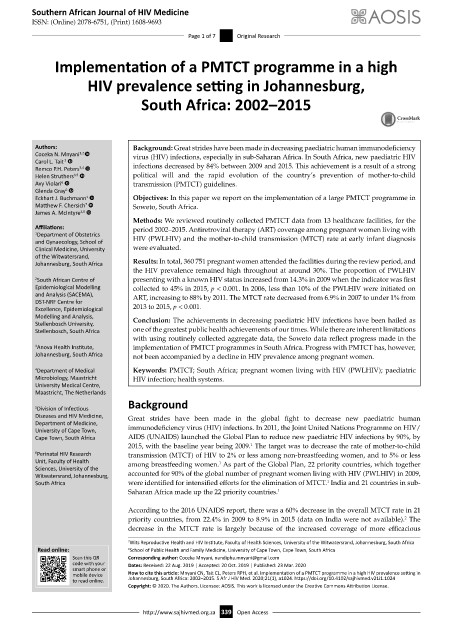Page 347 - HIVMED_v21_i1.indb
P. 347
Southern African Journal of HIV Medicine
ISSN: (Online) 2078-6751, (Print) 1608-9693
Page 1 of 7 Original Research
Implementation of a PMTCT programme in a high
HIV prevalence setting in Johannesburg,
South Africa: 2002–2015
Authors: Background: Great strides have been made in decreasing paediatric human immunodeficiency
Coceka N. Mnyani 1,2 virus (HIV) infections, especially in sub-Saharan Africa. In South Africa, new paediatric HIV
Carol L. Tait
3
Remco P.H. Peters infections decreased by 84% between 2009 and 2015. This achievement is a result of a strong
3,4
Helen Struthers political will and the rapid evolution of the country’s prevention of mother-to-child
3,5
Avy Violari 6 transmission (PMTCT) guidelines.
Glenda Gray 6
Eckhart J. Buchmann 1 Objectives: In this paper we report on the implementation of a large PMTCT programme in
Matthew F. Chersich 7 Soweto, South Africa.
James A. McIntyre
3,8
Methods: We reviewed routinely collected PMTCT data from 13 healthcare facilities, for the
Affiliations: period 2002–2015. Antiretroviral therapy (ART) coverage among pregnant women living with
1 Department of Obstetrics
and Gynaecology, School of HIV (PWLHIV) and the mother-to-child transmission (MTCT) rate at early infant diagnosis
Clinical Medicine, University were evaluated.
of the Witwatersrand,
Johannesburg, South Africa Results: In total, 360 751 pregnant women attended the facilities during the review period, and
the HIV prevalence remained high throughout at around 30%. The proportion of PWLHIV
2 South African Centre of presenting with a known HIV status increased from 14.3% in 2009 when the indicator was first
Epidemiological Modelling collected to 45% in 2015, p < 0.001. In 2006, less than 10% of the PWLHIV were initiated on
and Analysis (SACEMA), ART, increasing to 88% by 2011. The MTCT rate decreased from 6.9% in 2007 to under 1% from
DST-NRF Centre for
Excellence, Epidemiological 2013 to 2015, p < 0.001.
Modelling and Analysis, Conclusion: The achievements in decreasing paediatric HIV infections have been hailed as
Stellenbosch University,
Stellenbosch, South Africa one of the greatest public health achievements of our times. While there are inherent limitations
with using routinely collected aggregate data, the Soweto data reflect progress made in the
3 Anova Health Institute, implementation of PMTCT programmes in South Africa. Progress with PMTCT has, however,
Johannesburg, South Africa not been accompanied by a decline in HIV prevalence among pregnant women.
4 Department of Medical Keywords: PMTCT; South Africa; pregnant women living with HIV (PWLHIV); paediatric
Microbiology, Maastricht HIV infection; health systems.
University Medical Centre,
Maastricht, The Netherlands
Background
5 Division of Infectious
Diseases and HIV Medicine, Great strides have been made in the global fight to decrease new paediatric human
Department of Medicine,
University of Cape Town, immunodeficiency virus (HIV) infections. In 2011, the Joint United Nations Programme on HIV/
Cape Town, South Africa AIDS (UNAIDS) launched the Global Plan to reduce new paediatric HIV infections by 90%, by
2015, with the baseline year being 2009. The target was to decrease the rate of mother-to-child
1
6 Perinatal HIV Research transmission (MTCT) of HIV to 2% or less among non-breastfeeding women, and to 5% or less
Unit, Faculty of Health among breastfeeding women. As part of the Global Plan, 22 priority countries, which together
1
Sciences, University of the
Witwatersrand, Johannesburg, accounted for 90% of the global number of pregnant women living with HIV (PWLHIV) in 2009,
1
South Africa were identified for intensified efforts for the elimination of MTCT. India and 21 countries in sub-
Saharan Africa made up the 22 priority countries. 1
According to the 2016 UNAIDS report, there was a 60% decrease in the overall MTCT rate in 21
priority countries, from 22.4% in 2009 to 8.9% in 2015 (data on India were not available). The
2
decrease in the MTCT rate is largely because of the increased coverage of more efficacious
7 Wits Reproductive Health and HIV Institute, Faculty of Health Sciences, University of the Witwatersrand, Johannesburg, South Africa
Read online: 8 School of Public Health and Family Medicine, University of Cape Town, Cape Town, South Africa
Scan this QR Corresponding author: Coceka Mnyani, [email protected]
code with your Dates: Received: 22 Aug. 2019 | Accepted: 20 Oct. 2019 | Published: 23 Mar. 2020
smart phone or
mobile device How to cite this article: Mnyani CN, Tait CL, Peters RPH, et al. Implementation of a PMTCT programme in a high HIV prevalence setting in
Johannesburg, South Africa: 2002–2015. S Afr J HIV Med. 2020;21(1), a1024. https://doi.org/10.4102/sajhivmed.v21i1.1024
to read online.
Copyright: © 2020. The Authors. Licensee: AOSIS. This work is licensed under the Creative Commons Attribution License.
http://www.sajhivmed.org.za 339 Open Access

